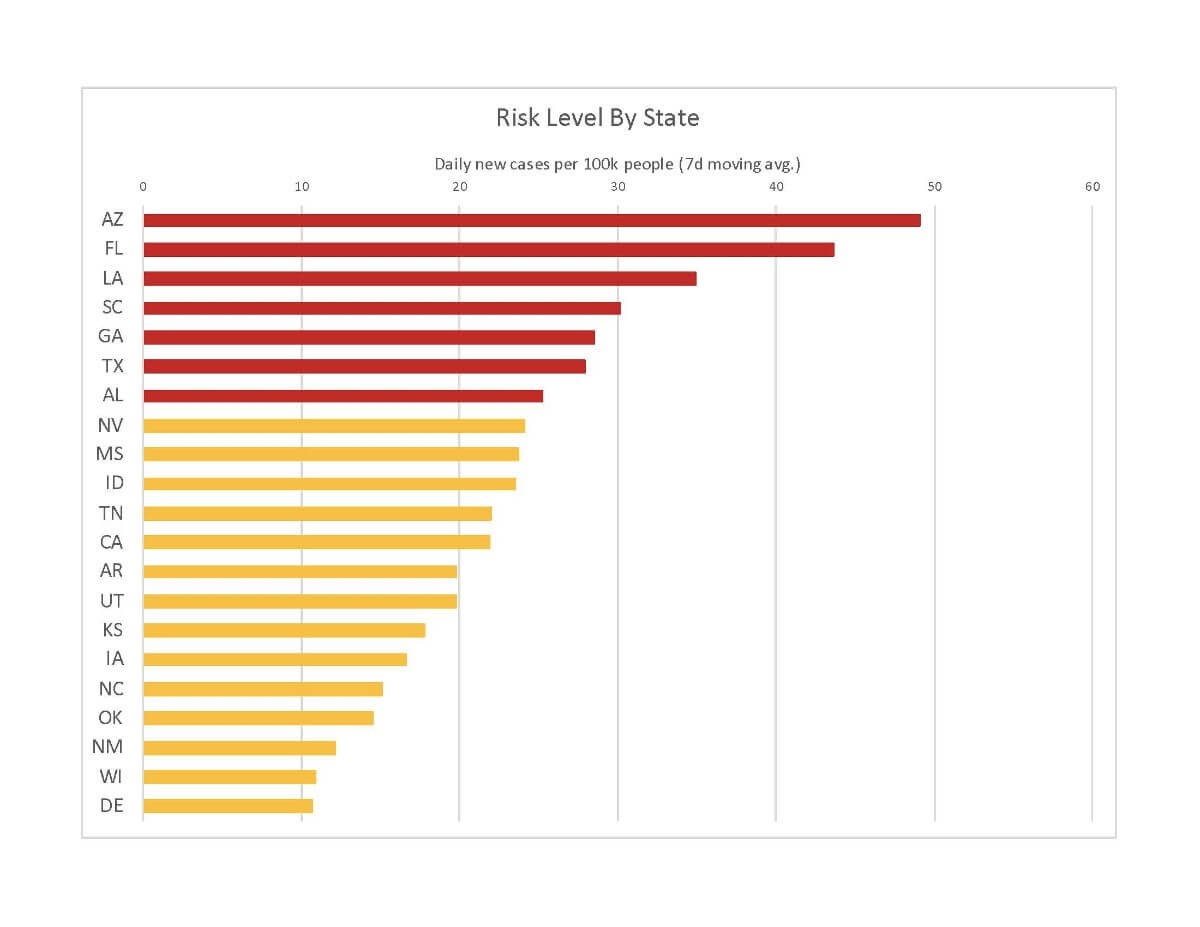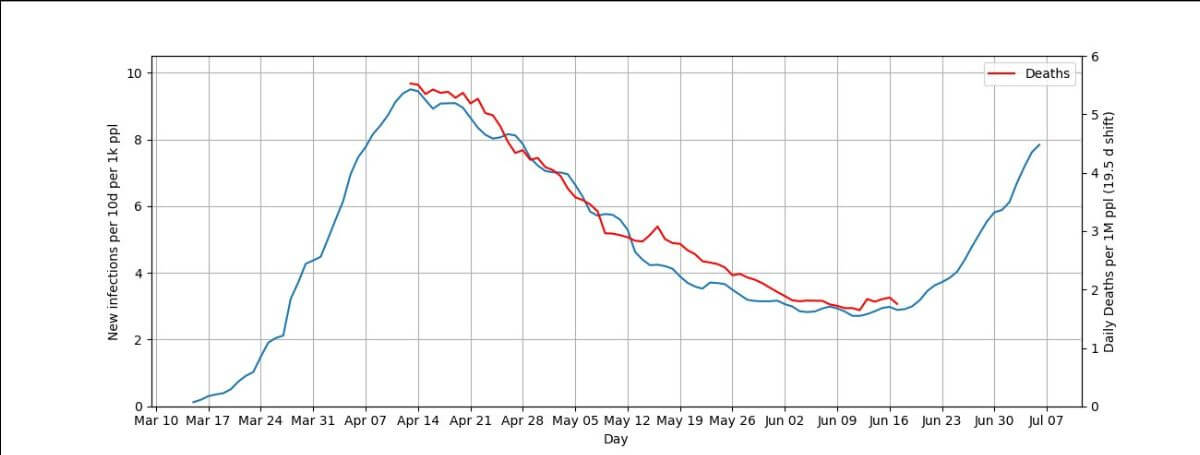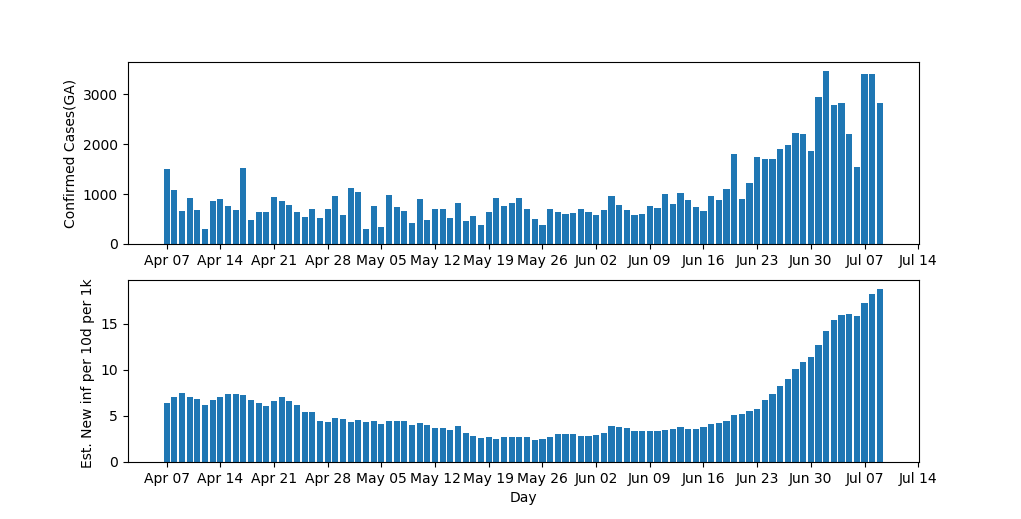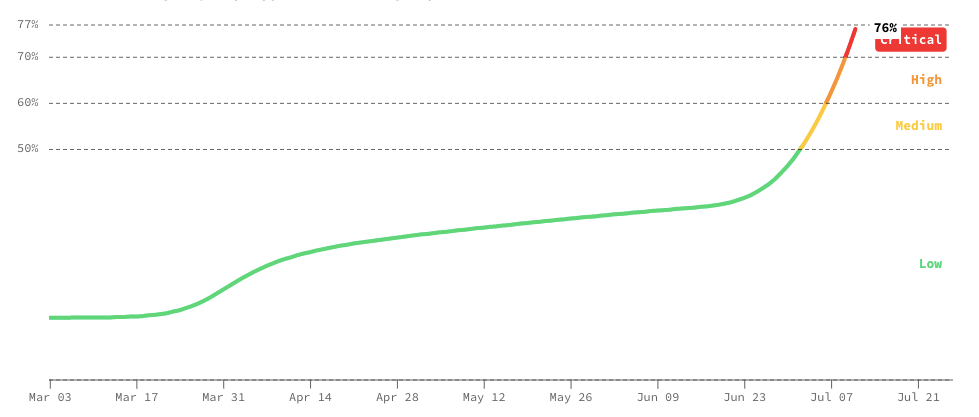Looking at the increase in cases during the last two weeks, I decided to dig into the numbers a little more, and here is what I have found.
The strategy, if there is one, is not working. Below is a chart showing the intensity in the worst 21 states determined by the 7-day moving average of daily cases per 100,000. The original chart and a county chart is available here. Those states that opened up early before they should have if they had followed CDC guidelines are performing worse than the rest.

Red: Tipping Point – Stay at Home
Orange: Accelerated Spread – Stay at Home Orders and/or Rigorous Test and Trace Programs advised.
Source: Harvard Global Health Institute
The strategy of protecting the elderly and allowing younger people to mix is also failing. Analysis by the Wall Street Journal shows, “Facilities in the Houston and Tampa metropolitan areas marked a nearly 800% cumulative increase in new cases among residents from the last week of May through the week ended June 28, the most recent period available, with more than 400 new cases during that period in both cities.” Thus these “walls” are too porous.
With the increases in cases in Florida, Texas, Georgia, Arizona, et al., testing facilities are getting backed up, resulting in longer lags between testing and getting results, allowing more people to get infected.
While deaths have not increased at the rate seen in the Northeast during the initial outbreak, many put that down to better treatment and remedies, but death rates are rising. A forboding chart, showing deaths and infections with a 19.5-day shift, produced by Dr. Blake. If this relationship holds, expect the average daily death rate to increase by 150% in the next few weeks.

Blue Line: New infections per 10 days per 1k ppl
Red Line: Daily Deaths per 1MM ppl with a 19.5-day shift.
Source Dr. Blake
As we struggle to fight COVID, lobbyists are once more wining the game. As The Washington Post points out, Emergent has received $628MM to develop manufacture a vaccine. Emergent is now the only maker of multiple drugs the government deems crucial for the Strategic National Stockpile, and the government is the company’s primary customer, accounting for most of its revenue. However, solely relying on Emergent creates:
- lack of price competition;
- risk of a single point of failure in the delivery of drugs; and
- creating a company that is too important to fail.
Reading the article, Emergent appears to overcharge the government. However, with 40 lobbyists and having spent over $40MM since going public, the payoff has been great – $20Bn in profits.
As I have said before, the market cannot solve public health crises because the incentives are misaligned. I doubt that much will change in DC, so expect more waste of government funds and increased profits for certain companies without any actual impact on the disease.
Returning to our current battle and bringing it a little closer to home, Dr. Blake provides some interesting information on Georgia’s infection density and inpatient census. At present, Georgia has 218 COVID-19 inpatients per 1M ppl. When inpatients hit 250 per 1MM ppl, expect some hospitals to start instituting elective halts.
Governor Kemp’s executive order preventing any city or county imposing a stricter lockdown than the State’s is an example of failed leadership. The virus is spreading, so some areas may need locking down while others not necessarily so. Thus his order is either too lenient or too strict depending on the situation. However, as we saw in Italy, too lenient doesn’t work for long. To paraphrase Ben Horowitz, “Leaders are there to make the unpopular decisions.” If they only implement popular decisions, no one needs them. This statement doesn’t mean that you apply those that are unpopular with your political opponents, but popular with your supporters, it means to do what is best for regardless of its popularity. Overall, Georga is is not trending well and doesn’t look good as we move towards schools opening in a few weeks.

With increasing cases, the death rate should increase; however, from the first lockdown, the issue was always overwhelming our hospital infrastructure. So what is the current situation?
According to COVID Act Now, “Georgia has about 2,833 ICU beds. Based on the best available data, we estimate that 61% (1,728) are currently occupied by non-COVID patients. Of the 1,105 ICU beds remaining, we estimate 841 are needed by COVID cases or 76% of available beds. This suggests hospitals cannot absorb a wave of new COVID infections without substantial surge capacity.”
The chart below shows Georgia’s ICU occupancy.

Critical is not where we want to be.
We already know there are ICU capacity issues in Texas, Florida, Mississippi, and Arizona., and it looks like Georiga is moving in the same direction.
Stay safe everyone, your family, friends, co-workers or employees, need you.
Recent Posts
Align and Thrive: The Importance of Organizational Alignment and Agility
Discover the importance of organizational alignment and agility in this blog post. Learn how establishing a strong CORE and building a strategy around it can lead to sustainable growth and success. Find out how alignment and agility empower your organization to thrive in an ever-changing business landscape.
How to Achieve Smart Time Management: 10 Tips for Busy Professionals
When you are a busy professional running your own business, it can often feel like there aren’t enough hours in the day to accomplish everything. Being strategic with your time is the best (and possibly the only) way to achieve all of your daily tasks. If you are...
5 Strategic Leadership Skills Every Manager Needs
So often, people view leadership as a talent: you’re either born with this quality or you’re not. However, this is not always the case! In reality, good leadership is made up of skills, and anyone can learn how to improve. Some people may pick up leadership attributes...
How the Sellability Score is Calculated: The Ultimate Guide
Do you have questions about how to calculate your business’s sellability score? Whether you’re looking to sell your business in the near future or years from now, understanding your sellability score will help you thrive. The sellability score identifies the...
The Top 5 Benefits of the Entrepreneurial Operating System
As an entrepreneur running your own business, you know there are bumps in the road and struggles that both you and your business will face over time. However, with the right people and tools at your disposal, you can anticipate what’s coming, plan for it, and continue...
5 Ways to Use Email Automation to Boost Traffic
Every single business in the world wants to evolve and grow. This will happen using a variety of techniques and strategies. In 2022, digital marketing is more than a household name, and most companies will adopt at least a few ideas when long-term planning and coming...
6 Questions To Ask A Potential Business Coach Before Hiring Them
Many entrepreneurs consider executive business coaching when they start struggling on their professional path. A small business coach is an experienced professional mentor who educates, supports, and motivates entrepreneurs. They will listen to your concerns, assess...
3 Ways Proper Long Term Strategic Planning Helps Your Business
Dreams turn into goals when they have a foundation of long-term strategic planning supporting them. They become reality when the ensuing strategic implementation plan is executed properly. With Kaizen Solutions as their strategic planning consultant, small and...
What is a Peer Group, and How Can it Improve Your Career?
If you are a CEO or key executive who has come to a crossroads or crisis in your career, you'll gain valuable insights and solutions from a peer group connection more than anywhere else. But what is a peer group, and how can that statement be made with so much...
Profit and Revenue are Lousy Core Values
As I mentioned last week, I am down with COVID and tired, so spending more time reading rather than working. I read Bill Browder's Freezing Order this weekend, and I highly recommend it. However, at the end of the book, Browder says that oligarchs, autocrats, and...









